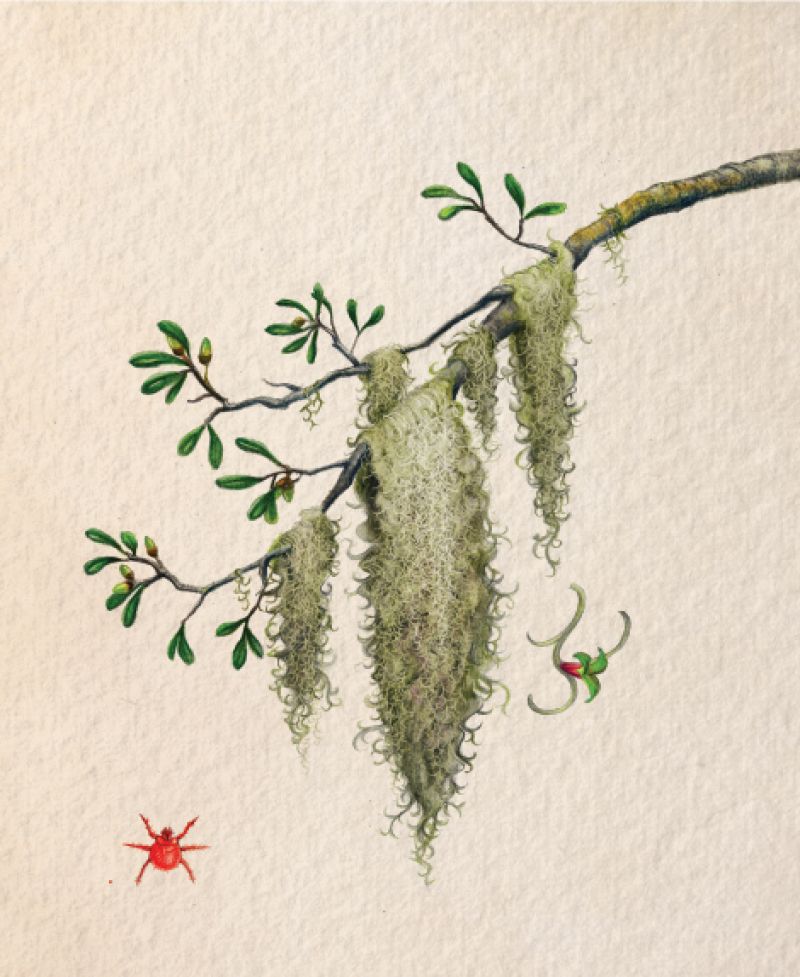
Did you know that Spanish moss isn’t a moss at all, but a bromeliad, that—rather fittingly—is cousin to the pineapple, Charleston’s symbol of welcome? And while the plant is a quintessential part of the Lowcountry landscape, draping over live oaks, crepe myrtles, even the occasional pine, there was a time when it also served practical purposes, being used as clothing, mulch, and a construction material. Don’t believe it? Read on
What's in a Name?
Native Americans called Spanish moss “tree hair.” In the 17th century, French explorers dubbed it “Spanish beard” as a derogatory slur against the Spanish, who returned the insult by calling it “French beard.” Early settlers used the name “gray beard.” Yet it was the term “Spanish moss” that survived.
living on air:
Tillandsia usneoides (which roughly translates to “looks like moss”) is an epiphyte, which grows on a host plant, but does not rely on it for food. This rootless tillandsia entwines itself around tree branches with extremely resilient long, thin stems similar in consistency to horsehair. The leaves are covered in cup-like silvery grey scales that collect moisture and nutrients from the air.
red scare:
Spanish moss has a reputation for housing redbugs (aka chiggers), but there’s good news if you decide to gather it: the itch-inducing critters aren’t usually found in moss growing in higher tree branches but in masses that have fallen to the ground or are living on smaller shrubs.
cash crop:
“Moss pickers” harvested, ginned, and baled Spanish moss just as they did cotton. A German visitor to South Carolina in 1825 noted that local merchants were exporting the “Spanish beard” to mattress makers in Europe. In 1939, more than 10,000 tons of the stuff were cured and ginned, bringing $2.5 million into the Depression-poor South.
green building:
Capable of absorbing water up to 10 times its dry weight, Spanish moss was used by coastal Indians to plug crevices in their bark-made huts and as a summertime roof covering that allowed in fresh air and provided shade. Learning from the Indians, early colonists mixed it with mud to make an incredibly strong mortar for building construction.
natural style:
Native coastal inhabitants wore clothing made with a material woven from “tree hair.” In 1670, a Charles Towne colonist noted that the native women were dressed in new moss “robes” that they were “never beholding” to a tailor for sewing up. They also used the plant as a sanitary napkin and even a form of baby diaper.
sow time:
Tiny, pale bluish-green flowers emanate a light, sweet fragrance. After the blooms are spent, a small fruit develops that eventually splits open to release seeds that are dispersed by wind and birds, making new plants.
Harvesting Spanish Moss
Want to snag some Spanish moss from a tree or shrub for decorative use at home? Cleaning it first is a must, as this bromeliad generally houses critters like the infamous—and itchy—red bug.
“People used to tell you to boil the moss, but that gets stinky,” says garden guru Joan McDonald. “The best way to clean it is in the microwave. Just dampen the moss, place it in a bowl, and nuke it for about 30 seconds, watching it carefully.” Afterward, remove the plant from the bowl and lay it out to dry on a towel.
From there, notes McDonald, you can use the moss for top-dressing planters (it’ll help keep moisture in the soil), making wreaths or “kissing balls,” and more.